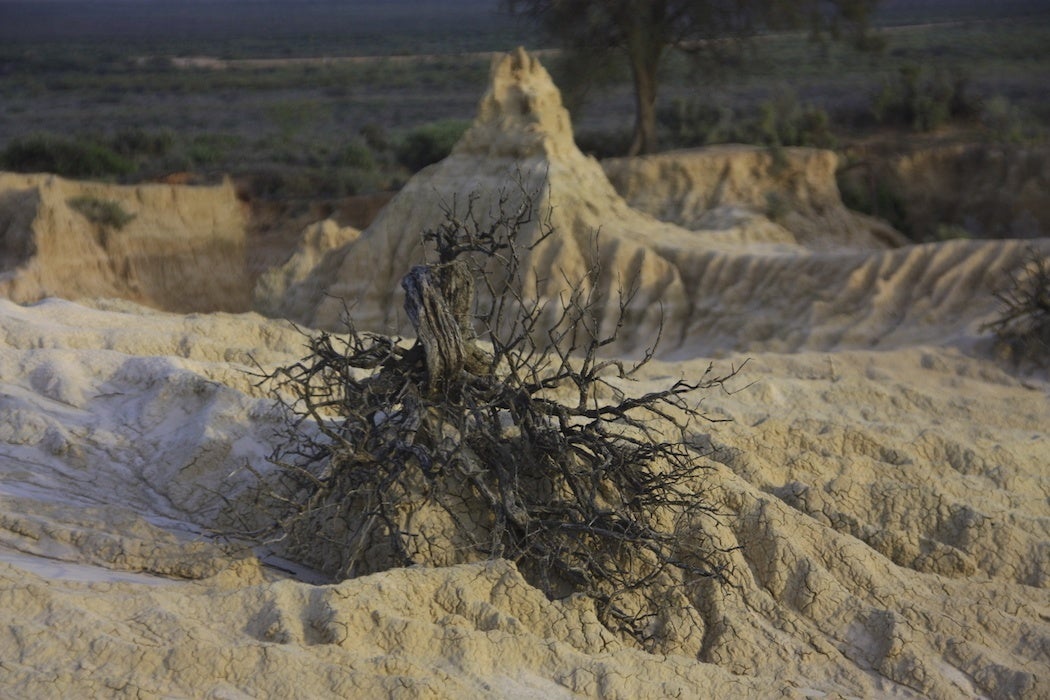For a visitor looking out at the sandy, crescent-shaped dunes of New South Wales, Australia, it’s difficult to imagine the place as it once was. Tens of thousands of years ago, the desert landscape, named Lake Mungo, was filled by lakes. Since then, the territory has been as it now appears—dry, dusty, semi-arid terrain.
This ability to make a particular landscape seem permanent despite massive changes is one of Earth’s greatest geological feats. At the same time, this kind of geological vanishing act makes it challenging to understand the history of human evolution; nothing ever stays the same. For generations, humans have strived to discover who our ancestors were and how we began as a species, but the clues we find are more like fuzzy traces than firm conclusions. Discoveries from Lake Mungo, however, have provided a more tangible link to our ancient past. For 40,000 years, these remnants remained buried in the sand, hidden by the changed landscape.
Although Major Thomas Mitchell first identified the dusty region as dry lakes in 1838, it wasn’t until the 1940s that geologists identified the dunes as being created by cycles of aridity and humidity during the last ice age. The leeward dunes, termed “lunettes,” provided a detailed record of the Quaternary period (a time period dating back 2.6 million years that includes the present) and the changes to the climate that occurred during it.
Then, when Jim Bowler discovered the cremated remains of a young woman in the dunes in 1969, the region’s reputation changed from geological jewel to archaeological treasure trove.
“Mungo Lady,” as she was later termed, was the first discovery Bowler made, and her bones had profound ramifications for archaeology and human history. Not only was she dated back to 41,000 years (an age 20,000 years older than scientists previously believed Aboriginal people had been in Australia), her bones also showed evidence of cremation, making her one of the oldest examples of cremated remains in the world. Cremation and other burial rites are often used as criteria for determining the level of culture possessed by the ancestral humans.
A mere five years later, Bowler discovered a second set of bones. Though “Mungo Man” didn’t exhibit signs of cremation, he was covered in red ochre, likely for cultural reasons. The discovery was a further departure from the theory that early humans emerged out of Africa and traveled first to Europe, then to Australia. Up until the Mungo Man find, the earliest evidence for human culture in Africa was from 50,000 years ago and, in Europe, from 40,000 years ago. If, as scientists initially believed, the bones were 60,000 years old, that would indicate either humans managed to reach the Far East 20,000 years earlier than they reached the West, or that modern humans evolved separately in Asia. The bones also offered an explanation of why Australia’s megafauna—including 2-ton wombats and 3-meter kangaroos—went extinct.
The Mungo Man mystery wasn’t solved until the early 2000s, when a coalition of scientists gathered to test the age of the remains and determined that they were between 40,000 and 42,000 years old, just like Mungo Lady. Despite moving the age forward, the enormous age of Mungo Man still meant that the Aboriginal people had to be sophisticated enough to build boats and travel the oceans to arrive in Australia from wherever they originally began.
But for all the excitement these two discoveries generated among the scientific community, they were less well received by Aboriginal people, who still claimed ownership of Mungo Lake and the surrounding land. The Mutthi Mutthi, Ngiyampaa, and Paakantji tribes all claimed the remains deserved to be returned to their homeland. As scientist Jim Bowler writes, “Hostility from indigenous owners at the removal of human remains and the exploitation of their history by white academics was matched by hostility from pastoral leaseholders at the declaration of World Heritage status without their prior consultation. Though the Aboriginals’ request was complied with for the Mungo Lady bones, Mungo Man remains under lock and key in an academic institution.”
Today Lake Mungo carries many identities: a tourist attraction in the middle of a desert; an untapped archaeological site where countless more skeletons may be uncovered by the shifting sands; and a battleground for indigenous land rights’ issues. But above all that is the lake’s ability to link past and present, to show the continuity of the people who have lived in Australia for tens of thousands of years. “[Lake Mungo] opens up deep time stories, stories integrating land and people,” Bowler writes, “inviting Australians to see past Gallipoli, to open hearts and psyche to that wider exploration of what it means to be Australian.”







